Butyriboletus regius (Krombh.) Arora & J.L. Frank - Royal Bolete
Phylum: Basidiomycota - Class: Agaricomycetes - Order: Boletales - Family: Boletaceae
Distribution - Taxonomic History- Etymology - Identification - Reference Sources
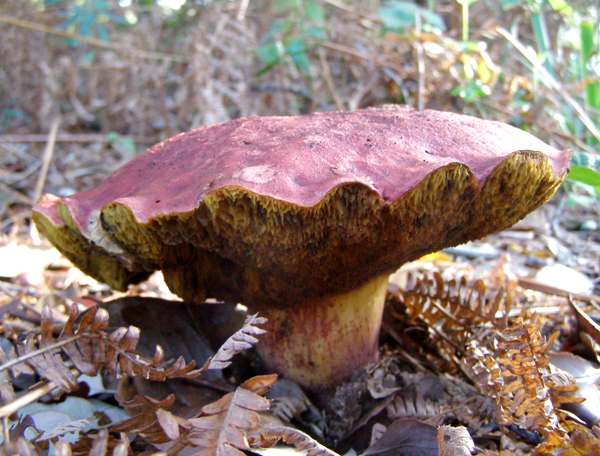
This large and impressive rare mushroom, until recently generally referred to by the scientific name Boletus regius Krombh., is protected under Schedule 8 of the Wildlife and Countryside Act, and picking fruitbodies of this critically endangered species is strictly forbidden.
Distribution
Butyriboletus regius is very rare in Britain, with just a couple of accepted records from Hampshire. Even in southern Europe (Portugal, Spain etc) these mushrooms are few and far between, and in many countries it is illegal to pick the fruitbodies.
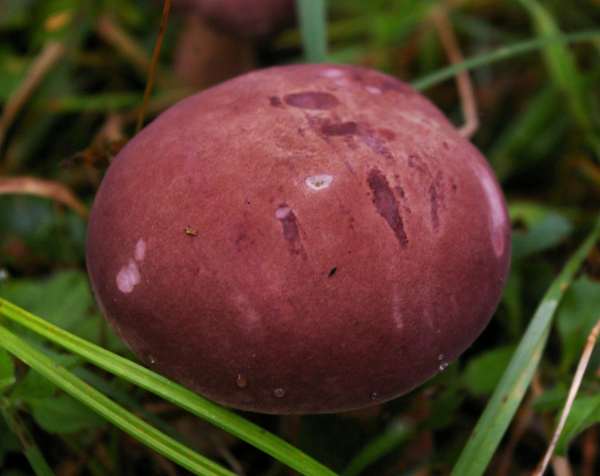
In Italy Butyriboletus regius is commonly known as Boleto Regio, and it is considered a good edible mushroom in the same culinary league as Ceps (Boletus edulis).
The Royal Bolete occurs in California and in some other Pacific coastal parts of North America, where it is commonly referred to as the Red Butter Bolete. Similarly, there are reports of this species occurring in Australia. Until DNA analysis proves otherwise, it seems appropriate to use the same name scientific name for Royal Boletes from Britain and Europe, North America, and Australia.
Taxonomic history
The Royal Bolete was first described in 1832 by the Bohemian mycologist Julius Vincenz von Krombholz (1782 - 1843), who called it Boletus regius, a most appropriate name that it retained until 2014, when Americans David Arora and Jonathan L. Frank transferred it to the new genus Butyriboletus, based largely on the results of molecular (DNA) analysis which has prompted a major revision of the family Boletaceae.
Butyriboletus regius has several synonyms, including Boletus regius Krombh., Boletus appendiculatus var. regius Konr., and Boletus subtomentosus ssp. cerasinus Martin.
Etymology
The generic name Boletus comes from the Greek bolos, meaning 'lump of clay', while the butyri- prefix to the new genus means 'buttery'. The regal appearance of this large bolete is reflected in both its specific epithet and its common name, neither of which require any explanation.
Identification guide
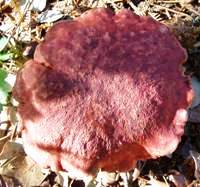 |
CapYoung caps of Butyriboletus regius are hemispherical and velvety, becoming smooth and often pitted or slightly wrinkled as the fruiting bodies mature. The cap surface is dark pink to red, sometimes with a yellowish or brownish tinge particularly near to the margin. Beneath the cap cuticle the flesh is yellow and either does not blue or turns slightly pale blue when cut. When fully expanded, the caps of the Royal Bolete range from 5 to 20cm in diameter and the margin usually becomes wavy. |
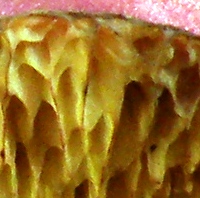 |
Tubes and PoresThe deep tubes (up to 2.5cm long) and angular pores of the Royal Bolete are yellow, darkening with age, and the tubes have adnate or slightly decurrent attachment to the stem. Pores spacing is typically 1mm. When bruised the pores of Royal Boletes found in Britain and Europe do not turn blue (although some blueing is reported from specimens growing in North America). |
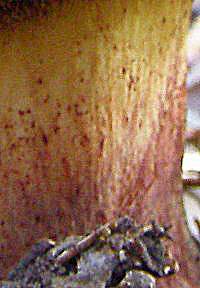 |
StemMainly yellow but with sometimes with red colouring, most often near the base, the stem is covered in a fine mesh network (reticulum) concolorous with the stem surface. (A closeup of part of a stem, left, shows how fine the reticulum is; a hand lens is a great help when studying such features in the field, especially with rare species where taking a specimen for closer inspection later is not an option.) The stem surface does not blue significantly when bruised. Variable in form but often slightly fusiform (barrel shaped) or with a somewhat bulbous base, stems range from 3 to 5cm in diameter and are typically 5 to 12 cm long. |
SporesNarrowly ellipsoidal to fusiform, smooth, 10.5-16 x 3-5µm; hyaline (translucent). Spore printOlive-brown. |
|
Odour/taste |
Pleasant but not distinctive. |
Habitat & Ecological role |
Ectomycorrhizal, found singly or in very small groups under various kinds of oaks as well as Beech and Sweet Chestnut trees in calcareous regions. |
Season |
Autumn. |
Occurrence |
Very rare in Britain and rare in some other European countries, noticeably Italy, France, Spain and Portugal, Boletus regius is also known to occur in parts of North America and in China. |
Similar species |
Hortiboletus rubellus, the Ruby Bolete (also first described by Julius Vincenz von Krombholz), is a much smaller and more gregarious bolete; it has a ruby-red cap but its stem is striate rather than reticulate. |
Reference Sources
Fascinated by Fungi, 2nd Edition, Pat O'Reilly 2016, reprinted by Coch-y-bonddu Books in 2022.
British Boletes, with keys to species, Geoffrey Kibby (self published) 3rd Edition 2012
Roy Watling & Hills, A.E. 2005. Boletes and their allies (revised and enlarged edition), - in: Henderson, D.M., Orton, P.D. & Watling, R. [eds]. British Fungus Flora. Agarics and boleti. Vol. 1. Royal Botanic Garden, Edinburgh.
BMS List of English Names for Fungi
Dictionary of the Fungi; Paul M. Kirk, Paul F. Cannon, David W. Minter and J. A. Stalpers; CABI, 2008
Taxonomic history and synonym information on these pages is drawn from many sources but in particular from the British Mycological Society's GB Checklist of Fungi.
Fascinated by Fungi. Back by popular demand, Pat O'Reilly's best-selling 450-page hardback book is available now. The latest second edition was republished with a sparkling new cover design in September 2022 by Coch-y-Bonddu Books. Full details and copies are available from the publisher's online bookshop...

